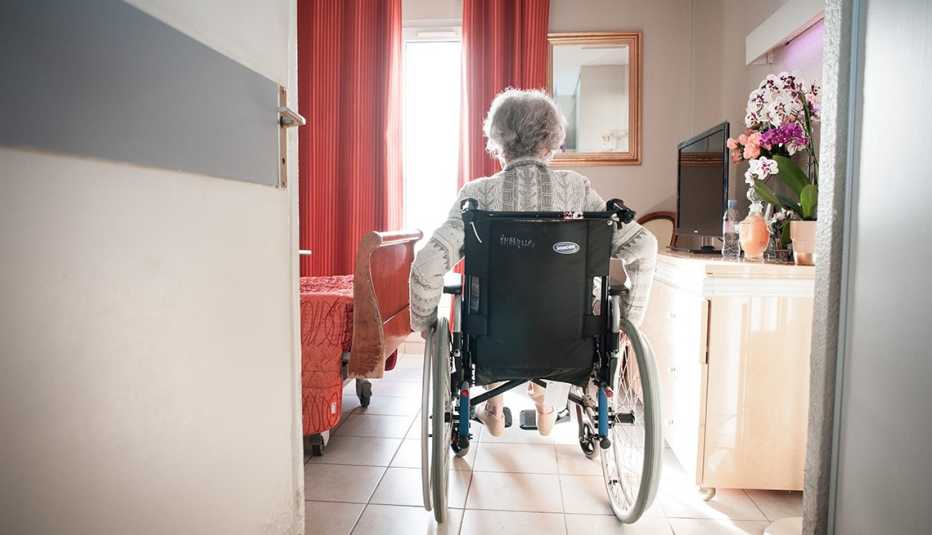AARP Hearing Center


Why are nursing homes so vulnerable to COVID-19?
Older people are at higher risk for COVID-19. So are people with chronic medical conditions, such as heart disease, diabetes, kidney disease and respiratory illness. Both groups are heavily represented among the nation's 1.3 million nursing home residents.
That concentration is a key reason why almost a quarter of U.S. deaths from COVID-19 have occurred among residents and staff at long-term care facilities, representing more than 200,000 pandemic victims, according to the Kaiser Family Foundation. But it's not the only one. A number of conditions at nursing homes can exacerbate the spread of the disease:
- Frequent physical contact between residents and staff
- Understaffing
- Employees who work in multiple facilities, increasing chances for exposure
- Residents sharing rooms
- Transfers of residents from hospitals and other settings
- Shortages of personal protective equipment (PPE) such as masks and gowns
- Lagging COVID-19 vaccination and booster rates
These factors make nursing homes potential breeding grounds for viral and bacterial diseases, especially given chronic problems with infection control that predate the pandemic. A May 2020 report from the U.S. Government Accountability Office found that 4 in 5 nursing homes surveyed between 2013 and 2017 were cited for deficiencies in infection prevention and control, leading the Centers for Medicare & Medicaid Services (CMS) to announce tougher rules for infection-control inspections and enforcement.
What's being done about it?
As the scale of COVID-19’s toll on nursing homes became clear during the pandemic, heightened infection-control protocols such as testing, masking, social distancing, hand hygiene and proper use of PPE were mandated in facilities. Early on, nursing homes essentially shut their doors in an effort to curb coronavirus entry and spread, instituting strict limits on visitation and suspending communal dining and other resident activities.
Residents and staff at nursing homes were in the first priority group to get vaccinated when America started rolling out its COVID-19 vaccines in late 2020. And residents were prioritized first for boosters in fall 2021 by the the Centers for Disease Control and Prevention (CDC).
As vaccinations increased throughout 2021 and as the rate of COVID-19 deaths in nursing homes declined, restrictions loosened, allowing more visitation and communal activities. But COVID-19 is still a threat to nursing home residents and staff, particularly given the rise of the recent omicron variant. Hundreds of residents continue to die from the virus each month, so some infection control practices remain, such as face coverings and physical distancing.
AARP and others long-term care advocates are working toward major long-term care reforms to ensure another crisis like COVID-19 is avoided. President Joe Biden recently unveiled a slew of proposed changes to how U.S. nursing homes are regulated and run, including a vow to adopt federal minimum staffing requirements for facilities, step up enforcement of regulations and crack down on overcrowded rooms. He touched on the reforms during his March State of the Union address, saying federal officials will “set higher standards for nursing homes and make sure your loved ones get the care they deserve and that they expect."
How are nursing home residents and staff getting COVID-19 vaccines and boosters?
In late 2020 and early 2021, the federal government contracted with CVS, Walgreens and some regional pharmacies to vaccinate residents and staff at most of the nation’s nursing homes and other long-term care facilities. COVID-19 vaccines and boosters, which the CDC recommends for those who live and work in long-term care settings, are now being allocated to pharmacies partnered with long-term care facilities, with facilities responsible for administering them. Facilities that don’t have a pharmacy partner are encouraged to work with local or state health departments or the federal government, if necessary.

































































More From AARP
10 COVID-19 Questions to Ask a Nursing Home
Guidance for caregivers during the COVID-19 pandemicWhat You Need to Know About the Coronavirus
The latest news on COVID-19 and answers to frequently asked questions